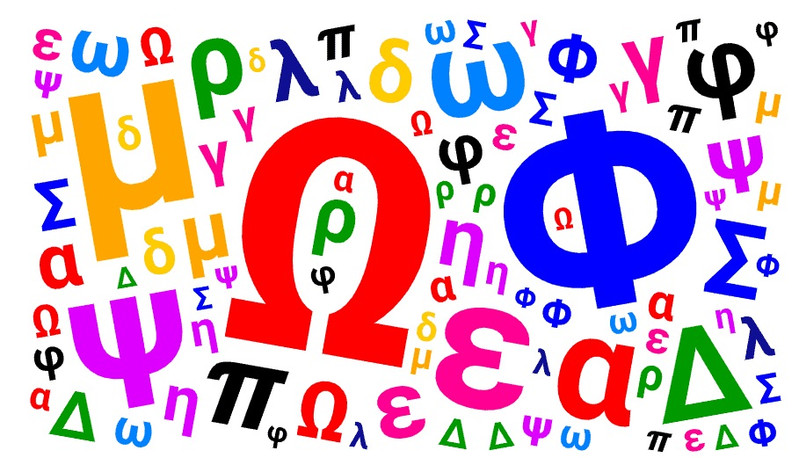The English alphabet formed from Roman-Latin, the Latin alphabet, emerged from the Old Italic alphabets, which in turn were derived from the Etruscan, Greek and Phoenician scripts where the ancient Greek language is centuries older than Latin and was 1500 BCE.

The Greek alphabet has 24 letters, each with uppercase and lowercase forms. These letters are often used as symbols for constants, variables, and special functions in mathematical and scientific notation.

Α α, alpha, άλφα
The ‘α’(alpha) is a letter of the Greek alphabet. In mathematics, physics, and engineering, it is often used to denote an angle, a coefficient of thermal expansion, as an alpha particle, and EMF interaction strength, alpha known as the beginning.
Β β, beta, βήτα
The ‘β’ (beta) symbol is commonly used to represent angles and are a special type of function, which is also known as Euler integral and is often used to denote a variable.
Γ γ, gamma, γάμμα
The gamma function (represented by Γ) is one commonly used extension of the factorial function to complex numbers and defined for all non-positive integer complex numbers.
Δ δ, delta, δέλτα
The Δ δ (delta) symbol is used in math as a change in a variable. In calculus, the symbol used in epsilon-delta notation when defining the limit operator.
Ε ε, epsilon, έψιλον
The ϵ (epsilon) symbol is an arbitrarily small quantity, used to indicate that a given quantity is small, or close to zero and is used in math as a variable to represent error bounds. For example, in calculus, limits are formally defined using the (ϵ,δ) (epsilon-delta) definition.
Ζ ζ, zeta, ζήτα
The Riemann zeta function or Euler–Riemann zeta function, denoted by the Greek letter ζ (zeta), is a mathematical function of a complex variable and function plays a role in analytic number theory, and applications in physics, probability theory, and applied statistics.
Η η, eta, ήτα
Rheology, η represents (mathematics) The metric tensor in quantum field theory. (chemistry, physics) The coefficient of viscosity. (engineering) Efficiency in engineering.
Θ θ, theta, θήτα
The letter θ (theta) is used in math as a variable to represent a measured angle. For example, the symbol theta appears in the three main trigonometric functions: sine, cosine, and tangent as the input variable and usually represents the angular position of a vector.
Ι ι, iota, ιώτα
Iota means a very small quantity or an infinitesimal amount, and the system of numerals has a value of 10, that can also represent the binary system in modern intergrated circuits.
Κ κ, kappa, κάππα
The K-function denoted κ is generalization of hyperfactorial to complex numbers. I.E. In graph theory, connectivity of a graph is given by κ and in differential geometry the curvature of a curve is given by κ and in linear algebra the condition number of a matrix is given by κ.
Λ λ, lamda, λάμβδα,
The λ (lambda) symbol is used throughout math, physics and computer science. For example, lambda is used to represent the eigenvalues of a matrix in linear algebra, the wavelength of a wave in physics and anonymous functions in computer science.
Μ μ, mu, μυ
A dipole moment is the product of the magnitude of the charge and the distance between the centers of the positive and negative charges. It is denoted by the Greek letter 'µ'.
Ν ν, nu, νυ
The symbols most often used for frequency are letters nu (ν) and omega (ω). Nu is used more often when specifying electromagnetic waves, such as light, X-rays, and gamma rays.
Ξ ξ, xi, ξι
The mathematical 'Ξ function' is used to describe the possible values of a random variable and their associated probabilities to known probability distribution thats used to denote the output coefficient.
Ο ο, omicron, όμικρον
Big O notation is a mathematical notation that describes the limiting behavior of a function when the argument tends towards a particular value or infinity While the symbol little-O is used to symbolically express the asymptotic behavior of a given function.
Π π, pi, πι
The symbol π denoting the ratio of the circumference of a circle to its diameter is number having a value rounded to eight decimal places of 3.14159265. pi. Also an infinite constant.
Ρ ρ, rho, ρο
The letter ρ (rho) is used in math as a variable and in statistics its used to represent population correlation while In physics its used to represent density.
Σ σ/ς, sigma, σίγμα
The capital letter sigma (Σ) means to sum up in mathematics while letter σ (sigma) is used in statistics to represent the standard of a population and in finance σ is the symbol used to represent volatility of stocks.
Τ τ, tau, ταυ
The Greek small letter τ (tau) is used in math as the circle constant to represent a full rotation around a circle in radians and the value of τ is approximately 6.283 and can be calculated by dividing any circle’s circumference by its radius.
Υ υ, upsilon, ύψιλον
Upsilon (υ) refers to the mass-to-light ratio. In statistics its used to indicate degrees of freedom. And in language is used to describe a positive amount close to 0 (zero).
Φ φ, phi, φι
The small letter Greek letter phi (ɸ) used to indicate phase. While the capital letter phi (Φ) is used to indicate a phased clock signal in an electrical circuit.
Χ χ, chi, χι
In mathematics the letter chi is used as a symbol for unknown function where the letter "x" is often used in algebra to mean a value that is not yet known or a unlocal missing value.
Ψ ψ, psi, ψι
The root ψ means “life”, “soul”, and “heart” and The letter psi is commonly used in physics to represent wave functions in quantum mechanics and also represents telekinetic energy.
Ω ω, omega, ωμέγα
In electromagnetism and engineering the uppercase Ω is used as the symbol for ohms which are the units of electrical resistance while in physics and other sciences the lowercase ω is often used to represent angular frequency and omega known as the end.
Mathmatic Report, Alec Bellamy
